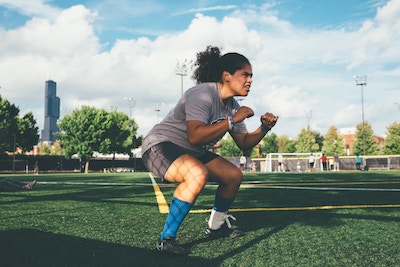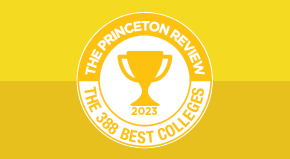Presented by Next College Student Athlete
Being a college athlete comes with a lot of benefits: competing in your sport at the next level, showing off your skills in front of hundreds—sometimes thousands—of fans, and receiving an athletic scholarship. However, the path to an athletic scholarship can be long and complicated.
Many athletes fail to achieve their goal of competing in college because they don’t understand how the recruiting process works. Here are five steps you take to stay on track for an athletic scholarship.
Step 1: Understand what Division level best matches your skill set, then start researching colleges
One of the most difficult parts of the recruiting process is understanding what division level is best for you. NCAA Division I athletics aren’t for everyone—in fact, only a select few athletes compete at D-I schools! To better understand where you fall, get evaluated by a third-party, or attend camps that attract other college-bound athletes to see how you compare.

After you’ve gained a better understanding of the division levels that are right for you, start researching schools you’re interested in. Organizations, such as the Next College Student Athlete (NCSA), typically recommend compiling an initial list of about fifty schools, which you will narrow down throughout your recruiting process. Consider a school’s location, academics, athletics, and culture as you’re creating your college list.
Step 2: Gather all the information you need
Before you start reaching out to college coaches, compile the following information into an athletic resume:
- Highlight or skills video (if one is required for your sport)
- Athletic stats
- Academic transcripts
- ACT scores, SAT scores, (or both!), if you’ve taken them
From there you will need to research and put together the numbers and email addresses of the head coaches, assistant coaches, and recruiting coordinators on your initial list of best fit schools. During this phase of your recruiting process, also check all your social media accounts to ensure that you don’t have any inappropriate content. Coaches (not to mention admissions officers) will look at all your social media!
Step 3: Start communicating with college coaches
NSCA recommends beginning your outreach by emailing coaches. Remember: Coaches get hundreds of emails each week, so yours really needs to stand out to get their attention:
- Make sure your email includes all the information in your athletic resume, especially a link to your highlight and/or skills video. This way, the coach can conduct an initial evaluation by watching your film.
- Your subject line should have your name, your position, your current grade level, and a key stat, for example “John Doe, High School Sophomore, Pitcher, 90 MPH fastball.”
- Avoid creating a mass email including every coach’s contact information on it. Instead, individually craft each email and, if possible, specifically state why you’re interested in that program.
After about two weeks, call the coach to express interest in their program: Avoid creating a mass email including every coach’s contact information on it. Instead, individually craft each email and, if possible, specifically state why you’re interested in that programMake sure you plan ahead so you know what to say if the coach picks up the phone—or if you are sent to their voicemail. Some student-athletes prefer to create a script and go from that. As you’re preparing, research some key facts about the school, the team’s past season and why you’re interested in that program.
Step 4: Manage your college recruiting process
As you’re reaching out and developing relationships with coaches at different schools, there are a few key actions you should be taking to keep your recruiting process moving forward:
- Keep checking your eligibility. You need to fulfill very specific requirements to be eligible to compete in college. Visit the NCAA Eligibility Center to double check the requirements—and ensure you’re on the right path to be eligible to compete at an NCAA institution. Similarly, follow the steps outlined by the NAIA Eligibility Center to discover if you’re academically eligible to compete at the NAIA level.
- Attend camps and combines. For some sports, attending camps is a great way to compete in front of coaches at schools you’re interested in. Many of these will be “pay to play” camps, so you’ll ideally want to attend camps at schools that are actively recruiting you. Attend combines to get verified, sport-specific stats that you can include in your recruiting resume.
- Go on campus visits. Seeing a campus in person is the best way to gauge if a school is a good fit for you. Before your visit call the coach at that school and find a time when they can meet with you. A crucial aspect of campus visits is getting an in-person meeting with the coach—which can even lead to offer.
- Send coaches your updated video and stats. Throughout this maintenance period, keep checking in with college coaches. A great excuse to send a coach an email? If you have an updated highlight video and new athletic or academic stats.
Step 5: Evaluate your athletic scholarship offers

By this point in the recruiting process, you’re getting ready to lock down your offer and negotiate your scholarship amount. To get your best offer, compare the financial aid packages available at each of the schools that have extended you an offer. If a program doesn’t have the budget to provide a huge athletic scholarship, the school will often try to make up the difference with merit-based, academic, or other types of scholarships. Make sure you don’t discount other types of scholarships as you’re making your final decision.
As you’re going through each of these steps, remember that the recruiting process is very different for each individual student-athlete. If you need personal assistance from a recruiting expert, Next College Student Athlete (NCSA), a college athlete recruiting network, offers services that can help. The NCSA staff of more than 600 former college athletes and coaches has been through this process thousands of times—and they have countless insider tips for helping athletes find their best college match.
Ready to take the first step toward an athletic scholarship?
The Princeton Review has partnered with Next College Student Athlete which provides college-bound athletes with an online recruiting profile for all of your necessary information as well as many other tools to help you easily manage your recruiting journey.
START YOUR FREE RECRUITING PROFILE
Explore Colleges For You
Connect with our featured colleges to find schools that both match your interests and are looking for students like you.
Get Started on Athletic Scholarships & Recruiting!
Join athletes who were discovered, recruited & often received scholarships after connecting with NCSA's 42,000 strong network of coaches.
Best 388 Colleges
154,000 students rate everything from their professors to their campus social scene.



